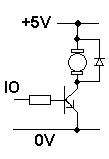I'm not a real expert in electronics but I'm going to start a new project that has completely captured me.
I need to drive a 12V pump with my Arduino Uno. The pump is "Dp0102" (12V, 0.7A). To power up the pump I wish to use an external switching power supply (12V - 88W) connected to a 12V relay and an optocoupler (maybe 4n35).
I was inspired by a project found on the web (Link), regarding driving a 12V fan. I would like to know whether it possible to modify and and use this circuit to drive a pump? Note that the fan's power consumption is about 1.2-1.7W but for the pump it is 8.4W. Should I use a transistor (instead of the optocoupler + 12V relay)? Can you help me choosing the right one?



